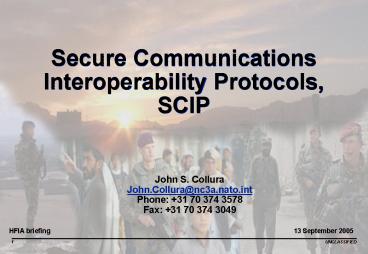Secure Communications Interoperability Protocols, SCIP - PowerPoint PPT Presentation
1 / 22
Title:
Secure Communications Interoperability Protocols, SCIP
Description:
Circa 1979, the STU-I used a digital signal processing computer. ... Based Upon common standards. Four Suppliers Built NBSV-II compatible products ... – PowerPoint PPT presentation
Number of Views:513
Avg rating:3.0/5.0
Title: Secure Communications Interoperability Protocols, SCIP
1
Secure Communications Interoperability
Protocols,SCIP
- John S. Collura
- John.Collura_at_nc3a.nato.int
- Phone 31 70 374 3578
- Fax 31 70 374 3049
HFIA briefing
13 September 2005
2
SIGSALY Secure Voice System
Circa 1943, SIGSALY provided perfect security for
secure voice communication among allies. Twelve
units were built and deployed in Washington,
London, Algiers, Brisbane , Paris ..
3
STU-I
Circa 1979, the STU-I used a digital signal
processing computer. A few hundred units were
eventually deployed.
4
Original STU-II
Circa 1982, the STU-II provided 2400 and 9600 bps
secure voice. A few thousand units were
eventually deployed.
5
Current SCIP Products
6
Historical Perspective on Interoperability
- Secure Voice Data Communications
- Moderate Availability Between National Armed
Forces, - Unavailable Between Strategic and Tactical
Operations, and - Unavailable Between NATO /or Coalition Allies
- NATO NBSV-II Created Interoperability
- Based Upon common standards
- Four Suppliers Built NBSV-II compatible products
- NATO key material for NATO communications, and
- National key material for sovereign
communications - NBSV-II is at the End of its Lifecycle
7
NATO Growth
- Membership Partners
- From 16 to 26 nations
- North African Partners
- Middle East Partners?
- Mission Responsibilities
- Former SFOR (now EU)
- KFOR, IFOR
- ISAF
- IRAQ
- Communities of Interest
8
Secure Communications Challenges
- Key Management
- Future NATO deployments Brigade Example
- Interoperability
- Common Waveforms no interoperability
- Net-Centricity
- Certificate Based Key Exchanges
9
Communications Security Approaches
- Application Layer Security Solutions
- SCIP
- Network Layer Security Solutions
- IPSEC, HAIPE (US)
- Link Encryption Security Solutions
10
Cryptographic Definitions - I
- Symmetric Key Material
- Asymmetric Key Exchange
- Certificates and Trusted Authorities
11
Cryptographic Definitions - II
- Electronic Key Management Systems (EKMS)
- Automated ordering, generation, distribution,
storage, security accounting, etc. - Flexibility
- account registration, management, access control
to key data functions - Speed
- DACAN provided EKMS or DEKMS
12
Cryptographic Definitions - III
- Traffic Encryption Suites
- Suite A
- Suite B
- Compromised Key Lists
- Certificate Revocation Lists
- Communities of Interest
13
Communities Of Interest
- NATO
- National
- Multi-lateral
- Coalition
- United Nations
- European Union
- Emergency Responders
- NGOs (Aid Agencies)
14
NATO Interoperability
- Standards (STANAGS)
- Success Stories
- NBSV-II (voice)
- Link-11 (data)
- HF-House series of STANAGs
- Current ISAF Solution ()
15
Future NATO Interoperability
- Electronic Key Management System
- SCIP, IPSEC
- Session Keys
- Multinational Key Management
- Software Reconfiguration
- Tailored COIs
- Compromise Recovery
16
NATO SCIP Requirements
- Need to capture NATO requirements
- Joint AHWG/3 AHWG/6 document
- AHWG/3 Signaling requirements
- AHWG/6 INFOSEC requirements
- Feed requirements to the I-ICWG
- Vendors must build to exactly the same standard
17
SCIP What is it?
- Secure Communications Protocol for
Interoperability - Application Layer
- Network Independent
- End-to-End Security
- Common Call Setup and
- Common Signaling
- Commercial Standards Infrastructure
- Multiple Cryptographic Solutions or COIs
- NATO, Coalition, National Sovereign, Commercial,
etc.
18
Minimum Interoperability Requirements
- 2400bps MELPe voice coding
- Clear and secure MELPe
- 2400bps synchronous data channel
- 3000bps asynchronous data channel
- Blank and burst mode
19
Future Developments
- Optional Voice coders
- 600bps MELPe
- 1200bps MELPe
- 16000bps CVSD
- IP interoperability
- VoIP/MoIP
- Gateway solutions
- Eurocom
- TACOMS POST-2000
- Military Radios
- Professional Mobile Radios
20
SCIP IPSEC
- Protocols Have Different Objectives
- Application Layer vs. Network Layer
- Network Independent vs. IP Networks
- Gateway Options
- Red or Black?
- IP Protocols of Interest
- STE, VoIP, ?
- Secure Wireless LANs
- SECNET-11/54
21
Conclusions
- Goal Secure Interoperable Infrastructure
- National Policies must support vision
- SCIP key enabler for NNEC
- NNEC changing NATO National
- Develop Policy
- Design Acquire Secure Communications Equipment
22
Questions?































